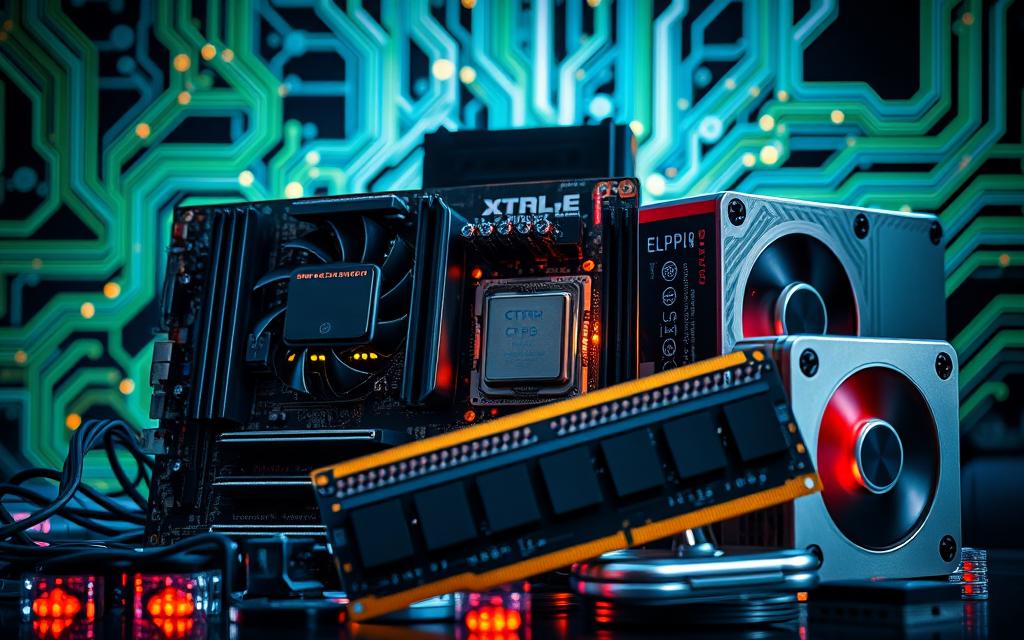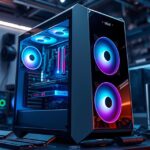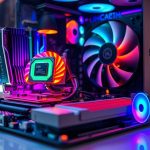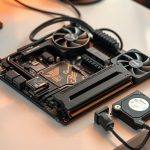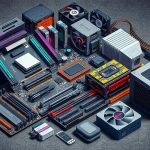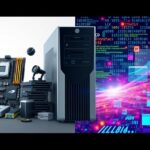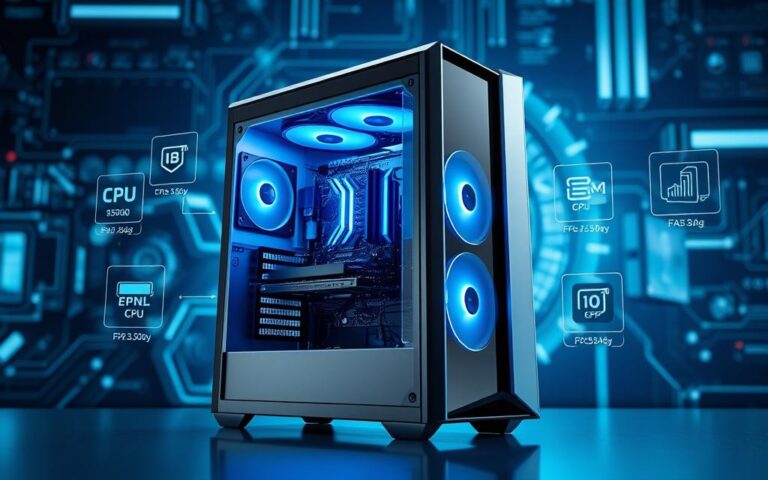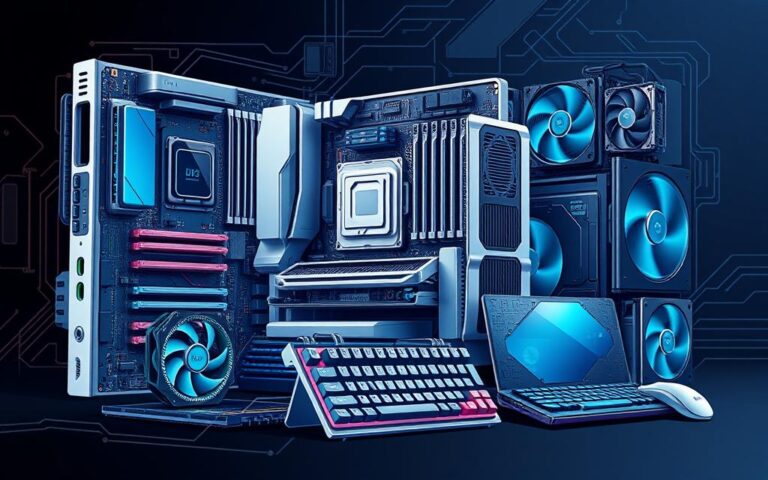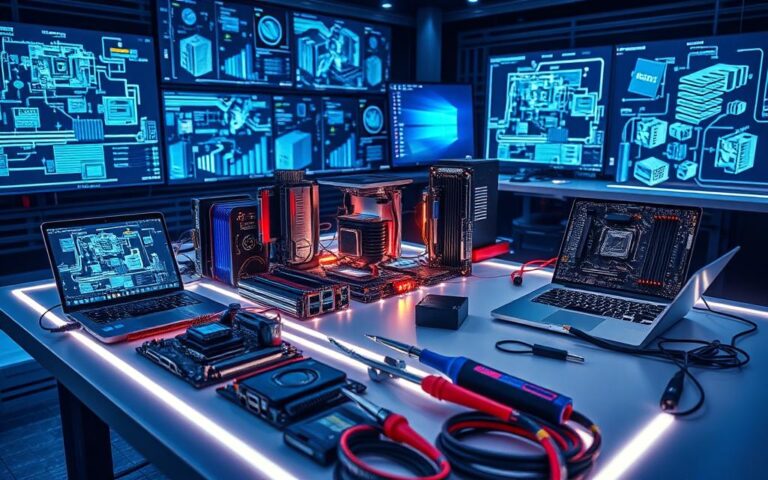What Does “Hardware” Mean in the Context of Computers?
When we talk about computing, “hardware” means the physical parts you can touch in a computer. This includes everything needed to make a computer work, both inside and out. It’s key to know what hardware is because it’s different from software. Software is the programs that tell the hardware what to do. The performance of a computer relies on how well its hardware and software work together.
We’re now going to look at what hardware means in computers. We’ll see why it’s so crucial. These components are the foundation of all the technology we use today.
Understanding Computer Hardware
Computer hardware includes the physical parts of computers, both old and new. Knowing what computer hardware is helps us understand how computers work. It consists of internal parts like the CPU and motherboards, and external parts like keyboards and screens. These components are the base that software needs to work, making different tech interactions possible.
Definition of Computer Hardware
Computer hardware is all the parts of a computer you can touch. It has processing units, storage, and parts that connect to networks, all important for the computer to work well. CPUs, which are internal, can work very fast, from 1.5GHz to 5GHz. Some can do many things at once, especially if they can handle multithreading up to four ways. The levels of cache memory in these CPUs, from level 1 to level 3, also play a big part in how well and how fast they work.
Importance of Hardware in Computing
Hardware is very important in computing. It affects how well and how fast a computer works. For example, the more RAM a computer has, the more data it can store quickly. Right now, 4GB is the least you should have, but for big tasks, 16GB or more is better. Modern motherboards have lots of ways to connect, like USB and Ethernet ports, making the computing experience better and smoother. Also, having good CPUs and graphic cards is key for top gaming experiences and happy users.
What Does Hardware Mean on a Computer
Knowing about computer hardware is key to understanding how it all works together. It’s the physical bits of a computer, like the Central Processing Unit (CPU) and ports. These parts are things you can touch.
Physical Components of a Computer System
Computer parts are either inside or outside. Inside, there’s the CPU, memory (RAM), and places to store data like SSDs or HDDs. Each one does a special job to help the computer run well. For instance, more RAM can make your computer quicker.

Outside, there are things like screens, keyboards, and printers. They hook up through ports, like USB or HDMI. Knowing about these helps with fixing, upgrading, or making your computer better.
When companies buy computers, they look at the CPU, RAM, and storage. These things decide how good the computers will be for work. For more details on hardware, check out this resource on hardware.
Types of Computer Hardware Components
Knowing the different types of hardware is key to making computers work better. This part talks about how internal and external hardware pieces fit together. They create a full system for handling data and interacting with users.
Internal Hardware Components
Internal hardware parts are key for a computer’s work. They’re the core of the system, handling data in many ways. Some main examples are:
- Central Processing Unit (CPU): Called the computer’s brain, it processes instructions and does calculations.
- Random Access Memory (RAM): This is short-term memory that holds data for fast access. It clears when the computer turns off. It comes in two kinds: DRAM and SRAM.
- Storage Devices: These are for keeping data safe. HDDs vary in speed, and SSDs are faster and use less power. SSD types like SATA, PCIe, NVMe, and M.2 fit different needs.
- Motherboard: It links all internal parts, making sure the CPU, RAM, and storage talk to each other.
External Hardware Components
External hardware, or peripherals, add to a computer’s skills. They help users interact and boost work performance. For instance:
- Input Devices: Keyboards and mice are basic ways to input info, especially in offices.
- Output Devices: Info comes out through monitors, printers, and speakers. Monitors now are slimmer and printers vary by type, like inkjet and laser.
- Peripheral Devices: Extras like external drives and USB sticks add more storage and features.
Internal Computer Hardware Components
Understanding computer internals is key for computing fans. The heart of computing includes the central processing unit, memory, storage, and the motherboard. Each plays a key role in how well a computer works.
Central Processing Unit (CPU)
The CPU is the brain of the computer. It handles calculations and commands, making the computer work. The clock speed is how we measure a CPU’s efficiency, affecting data processing speed. Today’s CPUs, like the Intel® Core™ i7-12850HX, have up to 16 cores. This boosts power and efficiency.
Random Access Memory (RAM)
RAM lets computers quickly access data for active tasks. It’s a temporary type of memory that clears when the computer turns off. Having more RAM means more apps can run at once. This is crucial for good multitasking and getting things done.
Storage Devices: HDD vs SSD
Storage devices keep your data safe. There are mainly hard drives (HDD) and solid-state drives (SSD). HDDs use spinning disks to store lots, usually 120GB to 4TB. SSDs use flash memory for quicker access and are more dependable. They also keep data without power. HDDs may cost less, but SSDs are better for their speed and toughness.
Motherboard and Its Role
The motherboard ties the computer’s components together. It lets the CPU, RAM, and storage communicate. This board hosts the CPU and has ports for adding extras. The choice of motherboard affects a computer’s speed and how much it can be upgraded.
External Computer Hardware Components
External computer hardware is key for better user experiences and strong computer interaction. These parts are divided into input and output devices. Input devices let us talk to our computer; output devices show us the results. Peripheral devices add more functions, helping us do more with our computers.
Input Devices
Input devices are tools that let us send data to our computer. We use several types:
- Keyboards – They’re crucial for typing letters, numbers, and commands.
- Mice – Help in moving the cursor and navigating on the screen.
- Microphones – Turn spoken words into digital signals for voice commands.
- Cameras – Great for taking photos and video chatting.
- Touchpads – Found on laptops, they let us control the cursor without a mouse.
These devices make it easier to interact with computer systems. They’re essential for many tasks.
Output Devices
Output devices show the computer’s work in an understandable way. Important ones include:
- Monitors – Let us see what the computer is doing, like viewing pictures.
- Printers – Turn files into printed pages.
- Speakers – Play sounds and music.
These are crucial for sharing what we do on our computers. They make it easy to understand our work’s results.
Peripheral Devices and Their Functions
Peripheral devices are extras that boost a computer’s skills. They include both input and output devices, making our experience better. Here are some examples:
| Device | Type | Functionality |
|---|---|---|
| External Hard Drive | Input/Output | Provides extra space for files and backup. |
| Webcam | Input | Makes video chatting possible. |
| USB Flash Drive | Input/Output | Good for moving and backing up files. |
| Sound Card | Output | Gives better sound for music and videos. |
| Graphics Card | Output | Improves how games and videos look. |
Peripheral devices enhance our computer’s input and output capabilities. They add more ways to use our computers, improving how happy we are with them.
Hardware vs. Software
Understanding the difference between hardware and software is crucial for anyone using a computer. Software consists of programs and instructions that run on hardware. This connection is vital for everything a computer does. Knowing how software and hardware work together helps us see how they make computing better.
Defining Software in Relation to Hardware
Software includes various types like system and application software. It enables hardware to function properly. For example, a CPU needs software instructions to work. Without this partnership, parts like hard drives and RAM wouldn’t work. The binary system, using 1s and 0s, turns software instructions into hardware actions.
How Hardware and Software Interact
The link between hardware and software is key to a computer’s success. The Von Neumann architecture lets computer memory hold both data and instructions. This setup lets parts like processors and storage do their jobs well. For instance, using Adobe Photoshop needs both software and hardware to work together for editing photos. Unlike hardware, software can get viruses, which shows why good security is important.
| Aspect | Hardware | Software |
|---|---|---|
| Definition | Tangible components of a computer system | Intangible code that runs on hardware |
| Types | Input Devices, Output Devices, Secondary Storage Devices, Internal Components | Application Software, System Software |
| Physical Presence | Can be seen and touched | Cannot be physically touched |
| Impact of Viruses | Not affected | Affected by bugs and viruses |
| Replacement | Can be replaced when damaged | Can be re-installed using backup copies |
Conclusion
The role of hardware in modern computing is huge and can’t be ignored. A look at hardware shows how crucial different parts are. This includes the CPU and RAM inside, as well as monitors and keyboards outside. Parts like SSDs have changed how we store data, making computers faster and more responsive.
The motherboard is key because it decides how parts fit and work together. Input and output devices let us talk to and get responses from our computers. All these parts need to work well together for the best experience.
If you’re getting into computing, it’s vital to understand how hardware and software interact. Their interaction makes computers work well. For more on this, check out the detailed info here. It covers each part’s role and their effect on computing today.
FAQ
What is the definition of computer hardware?
Computer hardware includes the physical parts of a computer. This includes the internal parts like the CPU, and the external parts like keyboards. They are crucial for running software and interacting with technology.
Why is hardware significant in computing?
Hardware’s importance in computing comes from how it affects efficiency and performance. The hardware’s quality determines a computer’s speed, productivity, and multitasking ability. This shapes the user’s computing experience.
What are the types of hardware components?
There are two main types of hardware: internal components like the CPU, and external ones known as peripherals. Peripherals include input devices (such as keyboards) and output devices (like printers).
What is the role of the CPU?
The Central Processing Unit (CPU) is the computer’s brain. It processes instructions from software. The CPU’s speed is key to how quickly it can process data.
How does RAM affect computing performance?
Random Access Memory (RAM) allows for quick access to data for the CPU. More RAM lets more applications run at once without slowing down the system. This boosts the ability to multitask.
What is the difference between HDD and SSD?
Hard Disk Drives (HDD) use spinning disks and are slower. Solid State Drives (SSD) use flash memory and offer quicker data access and reliability. SSDs are preferred for their speed.
What does the motherboard do?
The motherboard connects all internal hardware parts, allowing them to communicate. It determines compatibility and includes ports for peripherals.
Can you give examples of input and output devices?
Input devices, like keyboards and mice, let users enter data. Output devices, such as monitors and printers, show results in a way users can understand.
How are peripheral devices classified?
Peripherals are classified into input or output devices. They expand a computer’s functions, adding features like extra storage or video conferencing.
How do hardware and software interact?
Hardware and software work together for smooth computing. Hardware runs software instructions, completing tasks essential for a computer’s performance and functionality.
